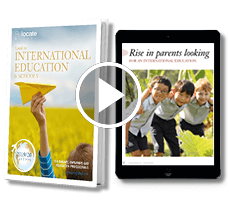Five key trends for international schools
Growth of international schools markets, especially in East, South and Southeast Asia, plus local demand - what are the trends in international education?
International schools: An expanding and thriving market
Celebrating its 25th anniversary this year, ISC Research has charted the expansion – both in number and geographic reach – of this important sector.The research and consultancy’s figures show that since 2000, when there were 2,584 international schools on the ISC Research database, the number of international schools has increased four-fold to 10,883 verified schools as of June 2019 – a figure that is still rising. More international schools are in the pipeline with predictions for a further almost-doubling of the number of schools, students and staff by 2029.Together, these figures from the past, present and future point to the continued rising popularity of this established route to higher education, and more choice for relocating – and now local – families.Keeping pace with change
But growth isn’t the only story. While there are now 239 countries or territories around the world where there are international schools, Diane Glass, ISC Research’s head of research observes: “If it’s true to say one of the key characteristics is growth, another for sure is its rate of change.”Among the key overall changes ISC Research notes is that routes to enrolment have changed significantly since 2000. A large element of the international schools’ growth is now being driven by local populations. The sector now is less expat-led and more price-sensitive.Nevertheless, it is one that still bodes well for families making an international move. Check out the following five trends to find out why.Trend 1: Further growth of international schools, especially in East, South and Southeast Asia
Demonstrating the first key trend in international school development is that three of the top four sub-regions with the highest number of international schools are all in Asia according to ISC Research’s data.ISC Research believes it is local families – including people on intra-regional moves – who are driving this growth, in recognition of the value an international education has for their children’s future prospects and higher education opportunities.Even in already well-served sub-regions, like the Middle East, the projections are for further growth; from 1,632 English-medium schools in 2018 to 2,513 by 2028. Saudi Arabia already has plans for 700 new schools by the end of the next decade.Affordability is key given the core market is families living on local salaries or assignees likely with a lump-sum or local-plus package.Curriculum is also critical in these fast-growing economies. Worldwide demand for English-medium learning, globally recognised qualifications and reliable routes to respected and world-renowned universities continue to grow, notes ISC Research.Overall, these trends and drivers mean more choice for the increasing diversity of relocating families.Trend 2: Maturing markets and local demand are broadening the international schools offer
With international education being influenced by growing middle-class and dual-income families in fast-growing economies, and less by western expatriates, ISC Research is seeing the international schools market offer a greater range of options across multiple price-points.The mature premium market in the Middle East and places like Hong Kong are seeing schools really look to what makes them different. Unique selling points have developed from the now-standard top-notch sports facilities, curriculum and co-branding. These now encompass a focus on the creative arts, technology to deliver learning and track outcomes, as well as study in areas like AI, innovative approaches to individuals’ wellbeing and learning journeys, partnering with high profile chefs to overhaul catering, and the creation of outside classrooms and learning environments that maximise the use of their location.These established schools are now being joined by mid-priced and lower-fee schools globally. In Thailand, for example, significant overseas property investment from China is helping to boost the number of international schools. School fees are often 30-40 per cent of those in China, though perhaps for a school slightly less comparable on quality.Trend 3: Accreditation will become more important for premium and mid-priced schools
International schools are looking to differentiate themselves on critical aspects like curricula, development and safeguarding in an already nuanced and now growing market. ISC Research envisages schools looking to set themselves apart from the competition will seek accreditation with quality-assurance bodies like the Council of British International Schools (COBIS). This, it believes, will become increasingly important for parents making choices for their children’s international education.Trend 4: International education delivered with a local accent
As the number of international schools grows, a preference among families for honouring local cultural norms and practices in education is also emerging. This is often within a fast-changing local regulatory framework.ISC Research is seeing more schools deliver bilingual and bi-cultural curricula. In China and Vietnam, to name two, there is strong demand from parents, supported in law, to complement the benefits of an international education with local practices and teaching.That’s not to say British or US approaches are less relevant. In Malaysia, for example, the British curriculum lends itself well to local systems, given its historical connections with the UK.
Trend 5: Branding becomes important in a highly competitive market
In mature markets, often where competition between schools is most intense, branding and a well-developed sense of identity in the marketplace is essential for best showcasing routes into higher education in the world’s best universities.Some British schools present in China also offer a separate brand to appeal more directly to the local market.
One aspect of this rise is the growth of schools’ groups. As well as there being more international schools, a higher proportion now belong to a wider network. In 2015, this was true for a quarter of international schools. Today, this has increased to almost a third, while the number of schools overall has grown. As well as brand recognition, being a member of a group of schools brings benefits of scale, including around the hot topic of teacher recruitment.
Looking ahead
Mirroring the increasing range of circumstances and assignment types, the thriving international school sector is offering more schools, choice and locations, and at different price points, to keep pace with demand from internationally mobile and a globally-minded local market. With such diversity, never before has having the right information about the options available been so key to making a good move for everyone.This article is from Relocate Global's Guide to International Education & Schools 2019/20 which is packed with expert tips and information for those relocating and the professionals supporting them. For volume options, co-branded editions, digital or online licence agreements and advertising opportunities, contact Fiona Murchie at +44 (0)1892 891334 or email fiona@relocatemagazine.comNow available as an ebook on Amazon! Simply download from Amazon onto your Kindle, mobile phone or tablet to read wherever you are!
Subscribe to Relocate Extra, our monthly newsletter, to get all the latest international assignments and global mobility news.Relocate’s new Global Mobility Toolkit provides free information, practical advice and support for HR, global mobility managers and global teams operating overseas.
 Access hundreds of global services and suppliers in our Online Directory
Access hundreds of global services and suppliers in our Online Directory For more education and school-related news, visit our Education and Schools pages.© 2019. This article first appeared in the 2019/20 edition of the Guide to International Education & Schools published by Relocate Global, Spray Hill, Hastings Road, Lamberhurst, Kent TN3 8JB. All rights reserved. This publication (or any part thereof) may not be reproduced in any form without the prior written permission of Relocate Global. Relocate Global accepts no liability for the accuracy of the contents or any opinions expressed herein.
For more education and school-related news, visit our Education and Schools pages.© 2019. This article first appeared in the 2019/20 edition of the Guide to International Education & Schools published by Relocate Global, Spray Hill, Hastings Road, Lamberhurst, Kent TN3 8JB. All rights reserved. This publication (or any part thereof) may not be reproduced in any form without the prior written permission of Relocate Global. Relocate Global accepts no liability for the accuracy of the contents or any opinions expressed herein.©2025 Re:locate magazine, published by Profile Locations, Spray Hill, Hastings Road, Lamberhurst, Kent TN3 8JB. All rights reserved. This publication (or any part thereof) may not be reproduced in any form without the prior written permission of Profile Locations. Profile Locations accepts no liability for the accuracy of the contents or any opinions expressed herein.






































